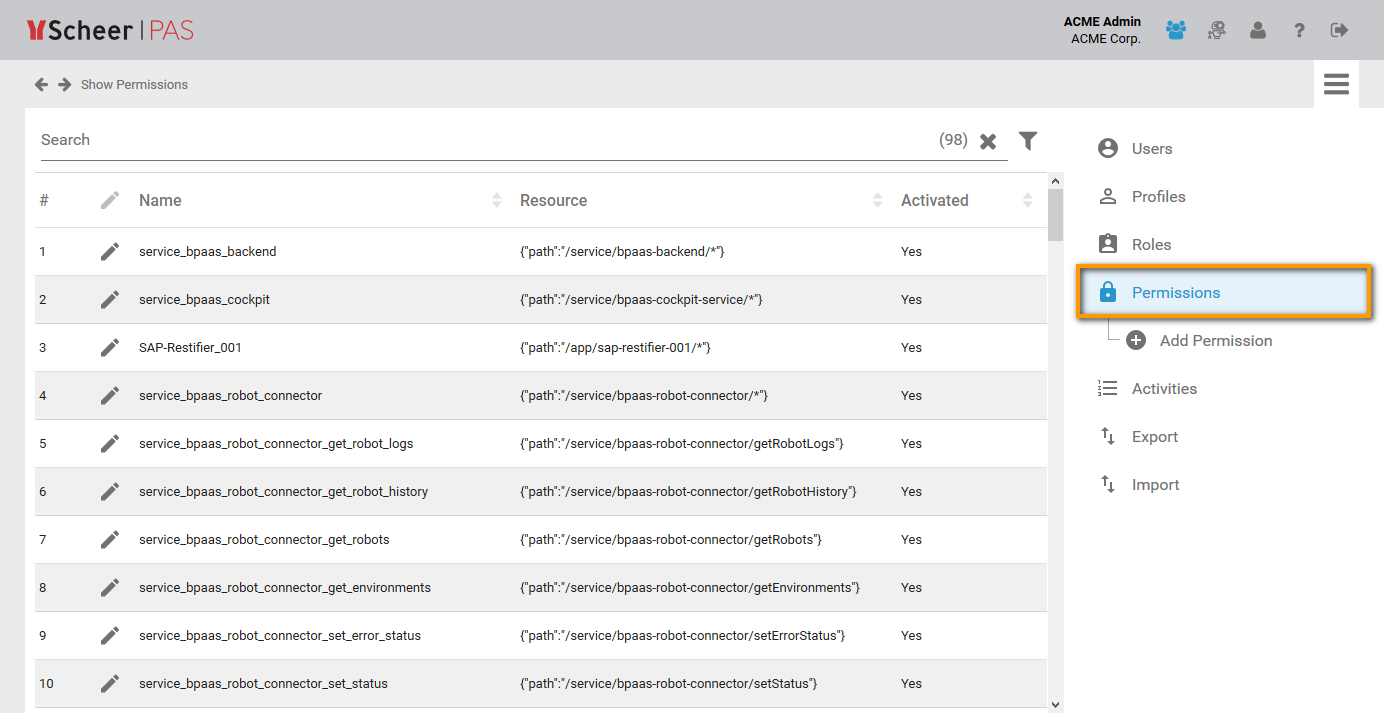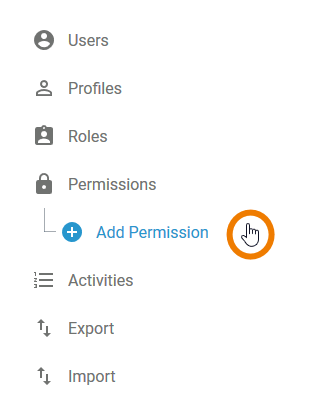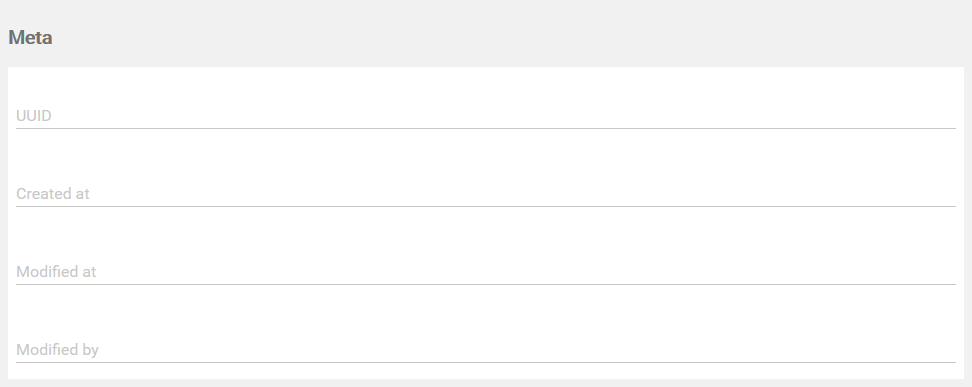- Created by Annegret Bernhardt, last modified on Jan 03, 2024
Permissions are designed to control access to URLs, for example the URL of the cockpit in your business system or the URL of a process app. Permissions are assigned to profiles. Depending on his allocated profiles, a user is authorized to open the cockpit, to work with process apps etc.
The authorization check of Scheer PAS Administration is based on Role-based Access Control (RBAC).
Menu "Permissions"
Menu Permissions allows you to create new permissions and to edit existing ones.
| Menu Permissions provides you with two options:
|
Existing permissions are listed in the content area if you select Permissions from the sidebar menu. The content is listed as follows:
- Name
- Resource
- Activated (Yes/No)

Use the filter to limit the content of the list.
Selecting menu item Add Permission opens an empty permission data sheet:

The Permission Data Sheet
The data of each permission is saved in a separate permission data sheet with the following sections:
Master Data
The basic data of a permission is managed in the Master Data section:

- Permission active: The checkbox indicates, if the permission has been activated. Default is active.
- Name: It is mandatory to insert the identifier for a new permission in the Name field.
Permission
A permission grants access to a defined sector of your business system. In the Permission section, you will have to insert the resource of that sector.
Do not change or create permissions without any knowledge of JSON.

You can choose additional resources by using the drop down list Possible Resource Information.
Available options are:
- Path
- Path with Variable

Meta
In section Meta, you can find the meta data of the permission containing the following information:
- UUID: The UUID allows to identify the permission.
- Created at: Contains the creation date of the permission.
- Modified at: Contains the date of the permissions' last modification.
- Modified by Contains another UUID which allows to identify the last editor of the permission.

The content of section Meta is for documentation purposes only: meta data cannot be changed.
Standard Permissions
Each Scheer PAS Administration is delivered with the standard permissions required for the use of Scheer PAS modules and components. The following table summarizes the standard permissions.
The table can be searched. To do this, enter your search phrase in the search field:
Oops, it seems that you need to place a table or a macro generating a table within the Table Filter macro.
The table is being loaded. Please wait for a bit ...
| Permission Name | Description |
|---|---|
| activity-service | Access to the activities |
| app_admin | Scheer PAS Administration (UI): Access using URL admin |
| app_file | File storage without profile check |
| app_storage | File storage with profile check |
| app_user_admin | Scheer PAS Administration (UI): Access using URL user-admin For backward compatibility only - default is app_admin |
| app-userself | User self service (UI) |
| bpaas_editor | BPaaS modeling (UI) |
| bpaas_execution | Execution engine for BPaaS apps |
| bpaas-cockpit | BPaaS cockpit (UI): Access using URL bpaas-cockpit For backward compatibility only - default is cockpit |
| bpaas-forms-connector-service | BPaaS integration of Scheer PAS Mobile (Backend) |
| cockpit | BPaaS cockpit (UI): Access using URL cockpit |
| designer-service | Editor for mobile forms (Backend) |
| form-designer-app | Editor for mobile forms (UI) |
ldap-auth-service | Access to LDAP service |
| pas_designer | Access to Scheer PAS Designer (UI) |
| pas_designer_service | Access to Scheer PAS Designer (Backend) |
| sap-restifier | Access to SAP Restifier |
| service_analytics_api | Scheer PAS Process Mining (Backend): Reading the analytics database |
| service_analytics_collector | Scheer PAS Process Mining (Backend): Collecting data from services |
service_analytics_etl | Scheer PAS Process Mining (Backend): Importing data to the analytics database |
| service_bpaas_backend | BPaaS modeling (Backend) |
| service_bpaas_cockpit | BPaaS cockpit (Backend) |
| service_bpaas_robot_connector | BPaaS integration of Scheer PAS RPA (Backend) |
| service_bpaas_robot_connector_continue_instance | Scheer PAS RPA (Backend): Continuing an instance |
| service_bpaas_robot_connector_get_current_user_job_queue_items | Scheer PAS RPA (Backend): Showing robot processes by user |
| service_bpaas_robot_connector_get_environments | Scheer PAS RPA (Backend): Reading the robot environments |
| service_bpaas_robot_connector_get_instance | Scheer PAS RPA (Backend): Loading an instance |
| service_bpaas_robot_connector_get_instance_from_queue | Scheer PAS RPA (Backend): Listing all queued instances |
| service_bpaas_robot_connector_get_jobs_stats | Scheer PAS RPA (Backend): Getting list of robot jobs |
| service_bpaas_robot_connector_get_process_information | Scheer PAS RPA (Backend): Listing robot process information |
service_bpaas_robot_connector_get_process_parameter | Scheer PAS RPA (Backend): Analyzing the UIPath process |
| service_bpaas_robot_connector_get_processes_by_environment | Scheer PAS RPA (Backend): Loading robot processes by environment |
| service_bpaas_robot_connector_get_robot_history | Scheer PAS RPA (Backend): Loading robot history |
| service_bpaas_robot_connector_get_robot_logs | Scheer PAS RPA (Backend): Loading robot logs |
| service_bpaas_robot_connector_get_robot_processes | Scheer PAS RPA (Backend): Loading robot processes |
| service_bpaas_robot_connector_get_robots | Scheer PAS RPA (Backend): Loading robots |
| service_bpaas_robot_connector_get_sessions | Scheer PAS RPA (Backend): Listing robot session information from the orchestrator |
| service_bpaas_robot_connector_get_sessions_stats | Scheer PAS RPA (Backend): Getting the total number of robots aggregated by robot state |
| service_bpaas_robot_connector_has_access_on_profile | Scheer PAS RPA (Backend): Checking robot authorization for profiles |
| service_bpaas_robot_connector_save_instance | Scheer PAS RPA (Backend): Saving an instance |
| service_bpaas_robot_connector_set_error_status | Scheer PAS RPA (Backend): Setting the error status of a robot |
| service_bpaas_robot_connector_set_status | Scheer PAS RPA (Backend): Setting the status of a robot |
| service_bpaas_robot_connector_start_instance | Scheer PAS RPA (Backend): Starting an instance |
| service_bpaas_robot_connector_start_robot | Scheer PAS RPA (Backend): Starting a robot |
| service_bpaas_robot_connector_start_robot_without_instance | Scheer PAS RPA (Backend): Starting a robot without requiring a PAS instance |
| service_cron | Time-controlled event execution (Backend) |
| service_cron-service_availableServices | Allows access to availableServices event of the service repository |
| service_cron-service_controlJob | Allows access to controlJob event of cron-service |
| service_cron-service_getJobs | Allows access to getJobs event of cron-service |
| service_cron-service_registerJob | Allows access to registerJob event of cron-service |
| service_cron-service_unregisterJob | Allows access to unregisterJob event of cron-service |
| service_mail | Email dispatch (Backend) |
| service_messaging-service | Access to messaging service |
| service_persistence | Database access (Backend) |
service_service-repository_get_version | Access to getVersion API from service repository |
| service_user_* | The access to the user administration is separated in multiple single permissions. For further information how to use these, please contact the Scheer PAS Support team. |
| service-reporting | MS Office data export (Backend) |
| service-userself | User self service (Backend) |
| transaction_logger | Saving the transaction logs for Scheer PAS Process Mining |
| xuml_library_repository | Access to xUML library repository |
xuml_library_repository_service | Access to xUML library repository service |
- No labels
